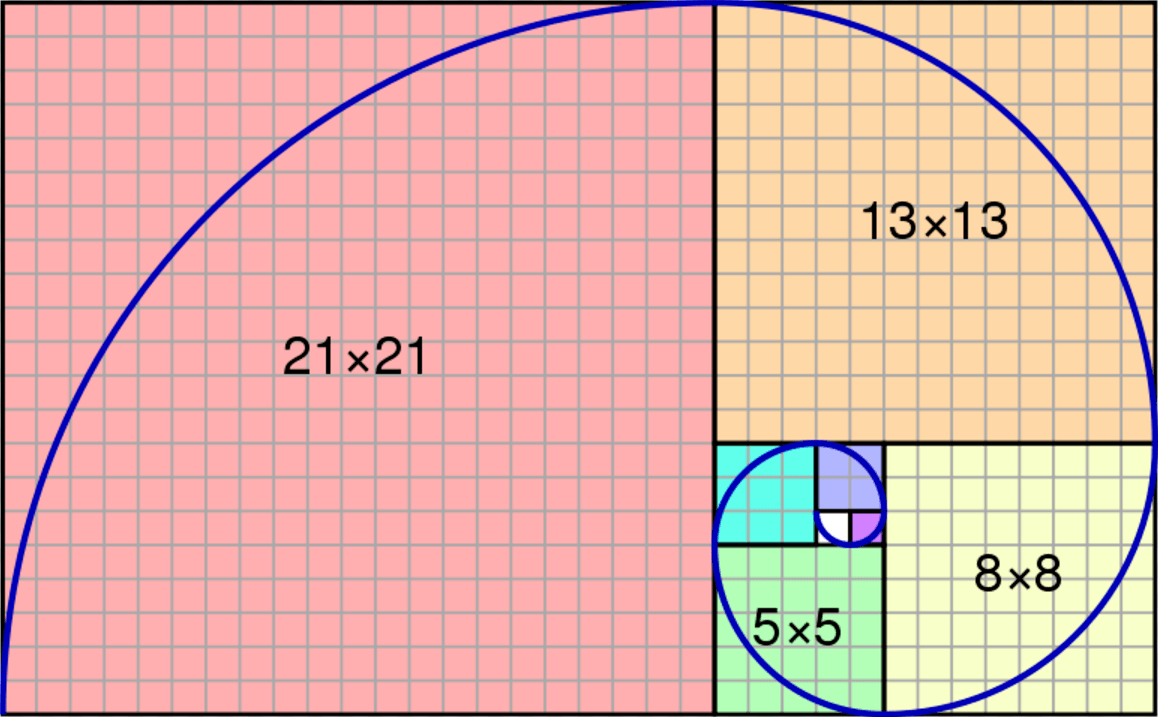Fibonacci Sequence in Art the Book of Squares Fibonacci
Summary: The Fibonacci Sequence is a peculiar serial of numbers from classical mathematics that has found applications in avant-garde mathematics, nature, statistics, computer scientific discipline, and Agile Development. Let'southward delve into the origins of the sequence and how it applies to Agile Development.
What Is The Fibonacci Sequence?
The Fibonacci sequence is a series of numbers where a number is the addition of the last 2 numbers, starting with 0, and 1.
The Fibonacci Sequence: 0, 1, 1, 2, iii, five, eight, xiii, 21, 34, 55…
Written every bit a rule, the expression is:
Xnorth = Xn-1 + Xnorthward-2
The Active Guide To Agile Development
This guide provides you with a framework for how to transition your team to agile.
The Fibonacci Spiral And The Golden Ratio
The Fibonacci sequence is often visualized in a graph such as the ane in the header of this commodity. Each of the squares illustrates the area of the side by side number in the sequence. The Fibonacci spiral is so drawn inside the squares by connecting the corners of the boxes.

The squares fit together perfectly because the ratio between the numbers in the Fibonacci sequence is very close to the gilt ratio [ane], which is approximately 1.618034. The larger the numbers in the Fibonacci sequence, the closer the ratio is to the golden ratio.
The screw and resulting rectangle are also known equally the Aureate Rectangle [2].
The Origins Of The Fibonacci Sequence
Fibbonaci (Leanardo Pisano Bogollo [3], Fibonacci was his nickname) outset introduced the series of numbers known every bit the Fibonacci sequence in his book Liver Abaci [4] in 1202. Fibonacci was a member of an important Italian trading family in the 12th and 13th century. Being part of a trading family, mathematics was an integral part of the business. Fibonacci traveled throughout the Middle Eastward and Bharat and was captivated by the mathematical ideas from his travels. His book, Liver Abaci, was a discourse on the mathematical methods in commerce that Fibonacci observed during his travels.
Fibonacci is remembered for ii important contributions to Western mathematics:
- He helped spread the use of Hindu systems of writing numbers in Europe (0,1,2,iii,four,5 in identify of Roman numerals).
- The seemingly insignificant series of numbers later named the Fibonacci Sequence subsequently him.
Fibonacci discovered the sequence by posing the following question:
If a pair of rabbits is placed in an enclosed area, how many rabbits volition be born there if we assume that every month a pair of rabbits produces another pair and that rabbits begin to bear young two months afterwards their birth?
- Kickoff: At the kickoff no rabbits are built-in, as the initial pair has not had time to be pregnant and born (0).
- The commencement month: 1 pair of rabbits are born (1).
- The second calendar month: Again, one pair of rabbits are born equally the new rabbits have not notwithstanding matured to bear young (1).
- The tertiary calendar month: Two pairs of rabbits reproduce, and one pair is not fix, so two pairs of rabbits are born (two).
- The fourth month: Three pairs of rabbits reproduce and 2 pairs of rabbits are not prepare, so three pairs of rabbits are born (iii).
- The 5th calendar month: Five pairs of rabbits produce and three are not ready, so five pairs of rabbits are born (5).
- And so on.
Though Fibonacci's question concerning the rabbits is an unrealistic scenario, the sequence can be observed in nature, such as in the array of sunflower seeds and other plants, and the shape of galaxies and hurricanes.

Sunflower Seeds are a dramatic demonstration the Fibonacci Sequence in nature.
The Importance of the Fibonacci Sequence
While this series of numbers from this simple brain teaser may seem inconsequential, it has been rediscovered in an astonishing variety of forms, from branches of avant-garde mathematics [five] to applications in computer science [6], statistics [vii], nature [8], and agile development.
How Τhe Fibonacci Sequence Ιs Used Ιn Agile Evolution
Now you may be proverb to yourself "That's nice, but what does information technology accept to do with Agile Development?", and that's a swell question. What does the Fibonacci Sequence accept to exercise with Active Development?Interestingly, the Fibonacci's Sequence is a useful tool for estimating the fourth dimension to consummate tasks.
Estimating Tasks In Agile
A big part of managing an Agile team is estimating the time tasks will have to complete. A points arrangement is oftentimes used to give a high-level estimate of the scale or size of a specific chore. Bigger more complex tasks go more points and smaller tasks get fewer points. Managers can and then review and prioritize tasks based upon the assigned scale.
Using The Fibonacci Sequence With Your Team
To use the Fibonacci Sequence, instruct your squad to score tasks from the Fibonacci Sequence upward to 21.
1, 2, 3, 5, 8, 13, 21
One being the smallest easiest tasks and twenty-one existence big projects. As far as why you should use the Fibonacci sequence instead of, say, t-shirt sizes, check back for my side by side article on 5 Reasons Using the Fibonacci Sequence Volition Make You Better at Estimating Tasks in Active Evolution.
And for more on leading an Agile eLearning Development squad, check out our sweet eBook guide, The Agile Guide to Agile Development.
Related articles:
1. 5 Reasons Using The Fibonacci Sequence Makes You Amend At Agile Evolution
2. eight Components And Uses Of Burndown Charts In Agile Evolution
3. eBook: The Agile Guide To Agile Development
References
- Gilt ratio
- Golden rectangle
- Leonardo Pisano Fibonacci
- Fibonacci'south Liber Abaci: A Translation into Modern English of Leonardo Pisano's Book of Calculation (Sources and Studies in the History of Mathematics and Physical Sciences)
- Fibonacci Sequence
- Why are Fibonacci numbers pregnant in calculator science?
- Fibonacci Numbers, Statistical Convergence and Applications
- Fibonacci in Nature
Source: https://elearningindustry.com/fibonacci-sequence-what-is-and-how-applies-agile-development